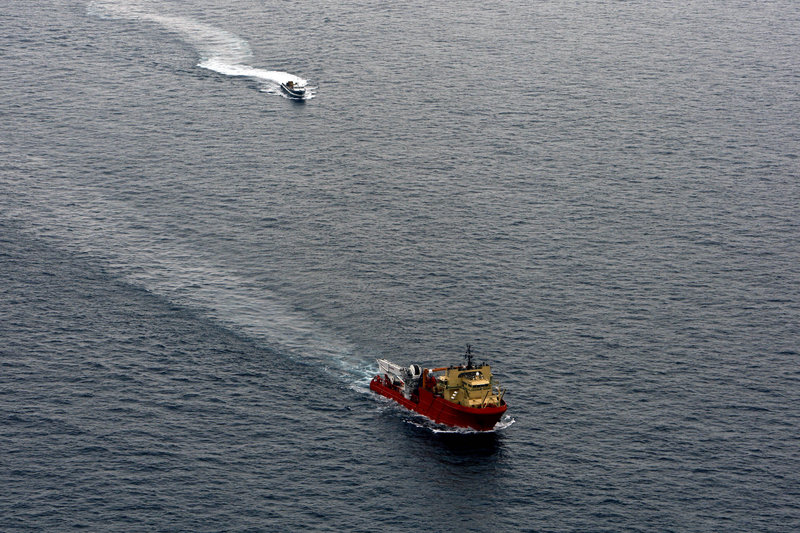ON THE GULF OF MEXICO – Ships relaying the sights and sounds from BP’s broken oil well stood fast Friday as the leftovers of Tropical Storm Bonnie blew straight for the spill site, threatening to force a full evacuation that would leave engineers clueless about whether a makeshift cap on the gusher was holding.
Vessels connected to deep-sea robots equipped with cameras and seismic devices would be among the last to flee and would ride out the rough weather if possible, retired Coast Guard Adm. Thad Allen said.
“If conditions allow, they will remain through the passage of the storm,” he said in New Orleans.
Bonnie made landfall south of Miami early Friday as a feeble tropical storm with top sustained winds of 40 mph. It broke apart as it crossed Florida and was a tropical depression as it moved into the Gulf, but forecasters expected it to strengthen slightly and roll over the spill site around midday today.
The ships holding the robots would be among the first to return if forecasts force them to leave, but they could be gone for up to two days, said Allen, the federal government’s spill chief.
The mechanical plug that has mostly contained the oil for eight days will be left closed, Allen said, but if the robots are reeled in, the only way officials will know if the cap has failed will be if satellite and aerial views after the storm passes show oil pooling on the surface.
Audio surveillance gear left behind could tell BP whether the well is still stable, but scientists won’t be able to listen to the recordings until the ships return to the area.
Allen expressed increasing confidence in the experimental cap despite a few leaks that initially worried government experts. Scientists say even a severe storm shouldn’t affect the plug, nearly a mile beneath the ocean surface 40 miles from the Louisiana coast.
“There’s almost no chance it’ll have any impact on the well head or the cap because it’s right around 5,000 feet deep and even the largest waves won’t get down that far,” said Don Van Nieuwenhuise, director of professional geoscience programs at the University of Houston.
Crews of other vessels, including one boring the tunnel meant to kill the flow of crude for good, spent Friday hauling in their gear and getting out of the storm’s way. Workers were pulling up a mile of pipe and laying it on deck of the drilling rig so they could move to safer water, probably to the southwest flank of the storm.
“Preservation of life and preservation of equipment are our highest priorities,” said Allen, a veteran of the Coast Guard’s rescue mission after Hurricane Katrina.
At the spill site, the water no longer looks thick with gooey tar. But the oil is still there beneath the surface, staining the hulls of boats motoring around in it.
Strong winds and waves could help break up the oil further, but a storm surge also might push it into sensitive marsh areas.
“Those are two opposite consequences and we’re prepared to move out and aggressively attack this once the threat has passed through,” Allen said.
The foul weather has stalled progress toward killing the well and could delay until mid-August the sealing of the nearly two-mile underground shaft using mud and cement, Allen and BP say. BP had hoped to finish drilling a relief tunnel Friday, but had to plug it Wednesday to prepare for the storm.
On the tiny resort island of Grand Isle off the southeast Louisiana coast, workers packed up the oil removal operation, tearing down tents, tying down clean boom and loading oil-soaked boom into large containers so it won’t pollute the area if the storm causes flooding.
“Part of our severe-weather plan is to remove all the equipment from the beach,” said Coast Guard Lt. Cmd. Nan Bangs. “We don’t want to take a chance on something damaging the sand berm or the houses along there.”
Before the cap was attached and closed a week ago, the broken well spewed 94 million to 184 million gallons into the Gulf after the BP-leased Deepwater Horizon rig exploded April 20, killing 11 workers.
BP is likely to be fined per gallon spilled, although determining that could be difficult. Concentrations of underwater oil at least doubled in June, according to the National Oceanic and Atmospheric Administration.
Researchers at the University of South Florida said Friday they have the first scientific proof that two giant plumes of oil beneath the surface of the Gulf came from the broken well. BP initially denied the plumes even existed.
Send questions/comments to the editors.



Success. Please wait for the page to reload. If the page does not reload within 5 seconds, please refresh the page.
Enter your email and password to access comments.
Hi, to comment on stories you must . This profile is in addition to your subscription and website login.
Already have a commenting profile? .
Invalid username/password.
Please check your email to confirm and complete your registration.
Only subscribers are eligible to post comments. Please subscribe or login first for digital access. Here’s why.
Use the form below to reset your password. When you've submitted your account email, we will send an email with a reset code.